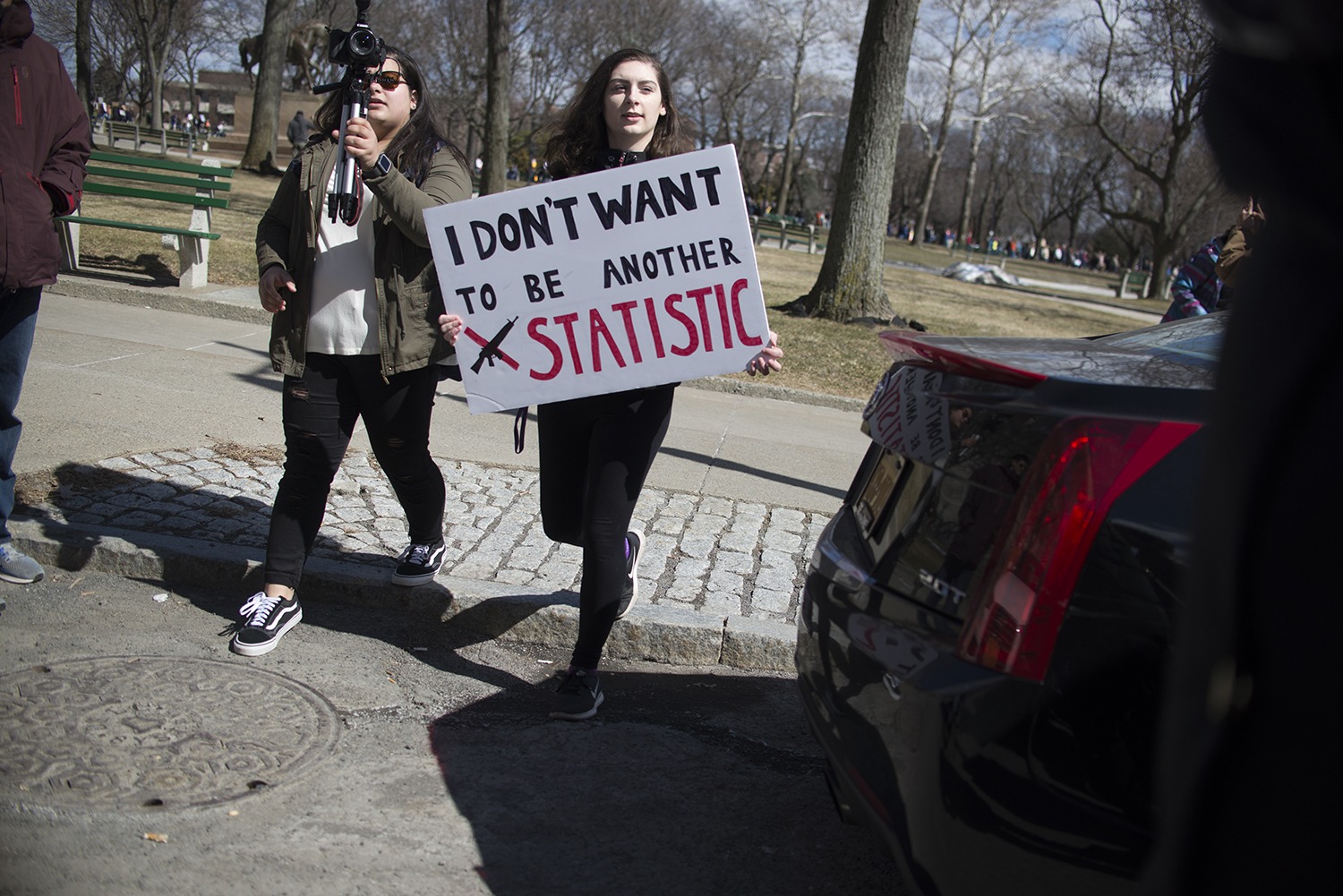
May 22, 2018
The mass shooting at Columbine High School in Littleton, Colorado, happened nearly two decades ago, yet it remains etched in the national consciousness. Columbine spurred a national debate — from personal safety to the security of schools, workplaces, and other locations and to broader considerations of guns and mental illness. To this day, communities still are grappling to find solutions to the complex and multifaceted nature of mass shootings.
Exacerbating this already complex issue is the prevalence of social media and never-ending wall-to-wall media coverage. Mass shootings, and those that are particularly lethal, are amplified by the news cycle, making them appear more commonplace when they are, in fact, statistically rare. Despite their episodic and highly sensational nature, however, not all mass shootings garner the same attention by the media.[1] Those shootings that are the most lethal may receive more coverage, while those events that are perceived as more “routine” by the media may not even be covered at all.
As a result of the intense and often unbalanced media coverage of mass shootings, members of the public may hold disproportional attitudes about the events themselves. Certain shootings, for example, may be perceived as indicators of a broader social problem, while others are considered to be isolated events.[2] Still, the collective phenomenon of mass shootings has been found to produce a host of outcomes for the public, including fear of crime, a potential moral panic, and the general belief that these events are more prevalent than their actual occurrence.[3]
Like the public, policymakers also have struggled with how to respond to mass shootings. Most policies center on either further restricting or expanding rights related to gun ownership and carrying, with a lesser emphasis on mental health protocols, regulating violent media, or policies related to security practices. More often than not, in the immediate aftermath of a mass shooting, a flurry of bills are introduced, but few, if any, are ever enacted into legislation.[4] Further compounding the issue is that the new laws that are passed, or even those that have been on the books for decades, often either are not enforced or, in other cases, are found to be ineffective at preventing the next mass shooting.[5]
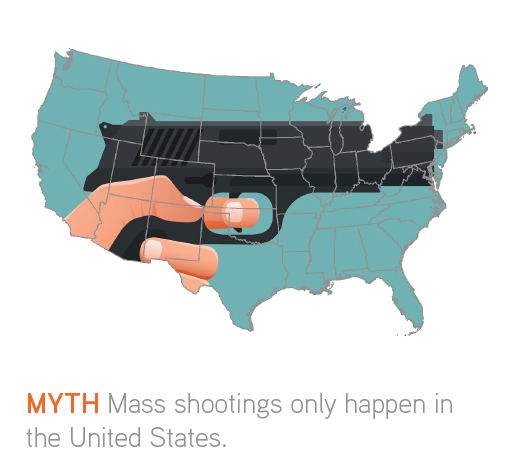







A central challenge in developing public policy solutions to mass shootings in America is the absence of a precise and generally accepted definition. Without this, the result is a distorted understanding of the actual context of the problem of mass and school shootings. Put plainly, we cannot solve a problem we do not fully understand.
There is wide variation on how mass shootings are defined. Various government organizations (e.g., the Centers for Disease Control, U.S. Department of Education), advocacy organizations (e.g., Everytown for Gun Safety), and other entities (e.g., GunViolenceArchive.org’s Mass Shootings Tracker) offer data that are based on their own descriptions that vary based on the number of victims (either killed or total shot), location, and the like. As a result, these definitions — several of which are discussed below — are inconsistent, overly broad, and ultimately lead to inflated statistics.
After the February 14, 2018, shooting at Marjory Stoneman Douglas High School in Parkland, Florida, for example, headlines around the country reported it to be the seventeenth school shooting of the year.[6] Many news outlets relied on data from a prominent gun control organization, Everytown for Gun Safety. Everytown defines school shootings as “any time a firearm discharges a live round inside or into a school building or on or onto a school campus or grounds, as documented by the press and, when necessary, confirmed through further inquiries with law enforcement or school officials.”[7] Based on this definition, and subsequently included in their compiled data, are attempted or completed suicides, accidental discharges, and purposeful discharges in which no one is injured or killed. When the seventeen events reported by Everytown for 2018 (through the Marjory Stoneman Douglas shooting) are separated based on their context, the number of school shootings in the more “traditional” sense (using Columbine as a template) is reduced to three. This, of course, creates issues developing appropriate policies and responses. Since these situations all required qualitatively different responses from school administrators, law enforcement officials, and other vested stakeholders, treating them all the same for the purpose of providing more compelling statistics is problematic.
When the seventeen events reported by Everytown for 2018 (through the Marjory Stoneman Douglas shooting) are separated based on their context, the number of school shootings in the more “traditional” sense (using Columbine as a template) is reduced to three.
More broadly, mass shootings also suffer from the same definitional issues. Often, whether an event qualifies as a mass shooting is contingent upon how many people are killed without consideration of the context surrounding the attack. Like school shootings, however, there are situational differences between multiple victim fatality situations such as familicides (the killing of one’s family), gang shootings, and even terrorism events in terms of prevention and response.
Further, events may not qualify as mass shootings when they do not meet a requisite number of fatalities (typically four, depending on the definition), despite that the intent and opportunity for the perpetrator was present. For example, a 2015 Congressional Research Service report defines a mass shooting as “a multiple homicide incident in which four or more victims are murdered with firearms, within one event, and in one or more locations in close proximity.”[8] Such a definition, however, can be limited in that it misses events — thereby creating false negatives in the accompanying data.[9] The May 21, 1998, shooting at Thurston High School in Springfield, Oregon, highlights this issue. The fifteen-year-old shooter killed two students and wounded twenty-five others. Despite twenty-seven total victims, this case would have been excluded from this particular study for not having met the criteria for number of fatalities. Similarly, the twenty-two-year-old perpetrator in the December 11, 2012, shooting at the Clackamas Town Center in Clackamas, Oregon, killed two and wounded a third before his gun jammed. Despite that there were between 8,000 and 10,000 potential victims in the mall at the time of the event, this shooting too would have been excluded as a false negative.
In one of the most comprehensive studies of mass shootings in the United States to date, researchers Jaclyn Schildkraut and H. Jaymi Elsass evaluated existing definitions of mass shootings from a number of sources, identifying the benefits and deficiencies of each.[10] In doing so, they crafted their own definition aimed at overcoming the limitations of these previous descriptors, which serves as the basis for this report:
A mass shooting is an incident of targeted violence carried out by one or more shooters at one or more public or populated locations. Multiple victims (both injuries and fatalities) are associated with the attack, and both the victims and location(s) are chosen either at random or for their symbolic value. The event occurs within a single 24-hour period, though most attacks typically last only a few minutes. The motivation of the shooting must not correlate with gang violence or targeted militant or terroristic activity.
In addition to definitional issues of school and mass shootings, the absence of a single national database of mass shooting events makes it difficult to properly understand and address the problem. Using the above criteria, Schildkraut and Elsass created a comprehensive dataset of mass shootings. Identifying potential events through media accounts, existing databases, and web searches, they cross-referenced each shooting through at least three sources to ensure that it aligned with the definition.
In addition to definitional issues of school and mass shootings, the absence of a single national database of mass shooting events makes it difficult to properly understand and address the problem.
What they found was that over a fifty-one-year period stretching between 1966 and 2016, a total of 340 mass shootings occurred in the United States.[11] Collectively, these events resulted in 1,141 deaths and a total of 2,526 victims (both injured and killed). Across mass shooting events, the number of deaths ranged from zero to forty-nine, with the total number of victims (both injuries and fatalities) varying between two and 102. While the number of victims resulting from some events is high, the majority of shootings have far fewer victims, resulting in median number of deaths and total victims of two and five, respectively.
Mass shootings occur in a variety of locations, including (but not limited to), schools; workplaces; places of worship (e.g., churches, temples); restaurants; nightlife establishments (e.g., bars, clubs); malls; movie theaters; airports; hospitals; and government buildings. In some instances, they may occur in residential areas or may span multiple locations, with shooters adopting a spree-like format by going mobile.[12] Mass shootings occurred most frequently at workplaces and schools, which combined were the settings for more than 57 percent of events (Table 1). This finding is not entirely unexpected as the shooters have relative ease of access to their victims in their roles as current or former employees or students.
| Location Type | Events | % of Total |
| Workplace | 101 | 29.7% |
| School | 94 | 27.6% |
| Other | 35 | 10.3% |
| Multiple Locations | 30 | 8.8% |
| Restaurant/Nightlife | 24 | 7.1% |
| Shopping/Entertainment | 19 | 5.6% |
| Government/Military | 16 | 4.7% |
| Place of Worship | 12 | 3.5% |
| Residential | 9 | 2.6% |
The majority of mass shooting events were carried out with a single firearm (67.1 percent), although multiple weapons were used in approximately one-third of events (Figure 1). Handguns were the most commonly used weapon, with at least one being used in 75.6 percent of events (Figure 2). When only a single weapon was involved, handguns were significantly more likely to be used than any other type of gun (68.9 percent of events).[13] In 28.5 percent of events, at least one rifle was used. To a lesser extent (0.9 percent), other types of guns, such as machine guns, were used by shooters.
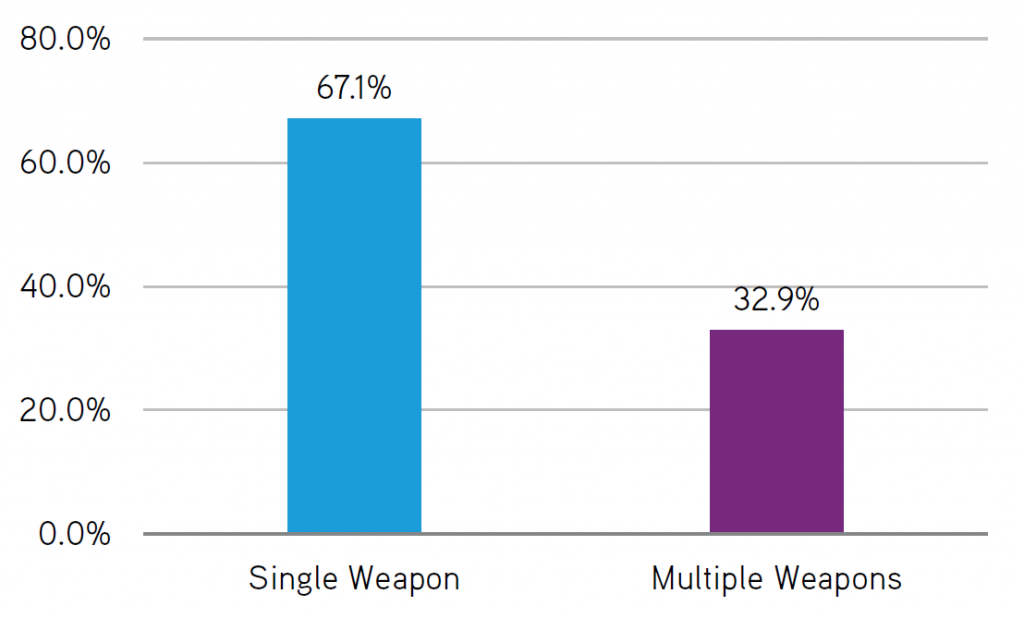
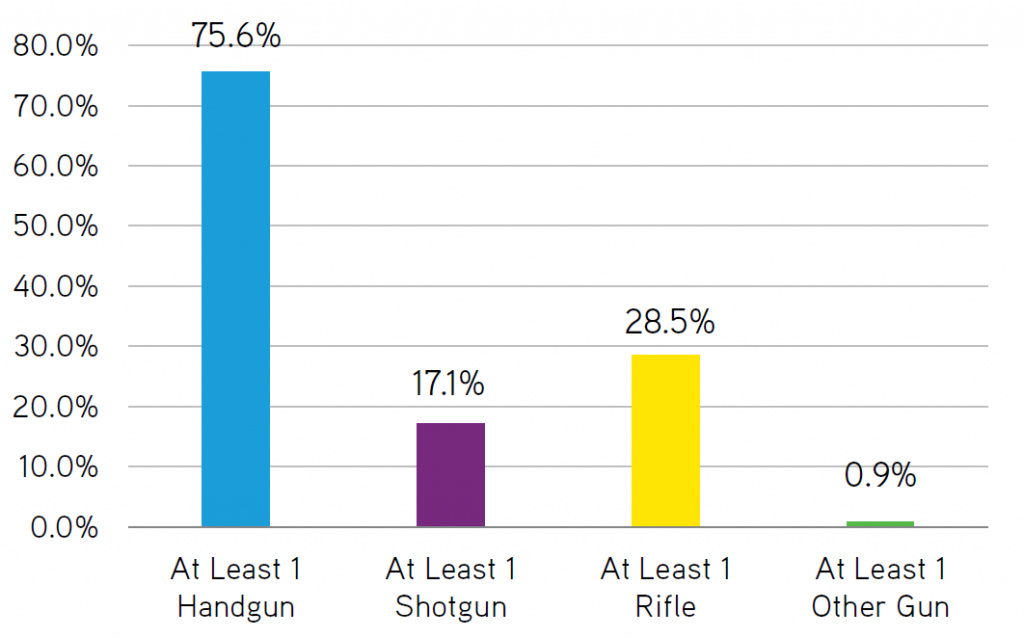
Across the 340 mass shootings identified between 1966 and 2016, there were 352 perpetrators. Just over 96 percent of the shooters were male, most of whom acted on their own (Figure 3). Conversely, there were just fourteen female offenders, twelve of whom acted alone. In just eight shootings (2.4 percent), multiple shooters were present. Mass shootings with co-offenders more commonly involved two or more males.
The distribution of age of the shooters is presented in Figure 4. The average age of a mass shooter is 33.4 years. The youngest shooter was eleven years of age, while the oldest was eighty-eight. Nearly half (46 percent) of the 352 shooters were under the age of thirty at the time of their crimes, with 16 percent of those perpetrators being juveniles (those individuals under the age of eighteen).
Race was reported for 304 (86 percent) of the shooters, the distribution of which is illustrated in Figure 5. Despite common misperceptions that all mass shooters are white, the findings indicate that while a majority are, this proportion is just over half of the perpetrators (53.9 percent). More than one in four shooters is black and nearly one in ten is of Hispanic descent. Fewer than 5 percent of mass shooters were classified as Asian, Native American, or of other racial or ethnic descent.
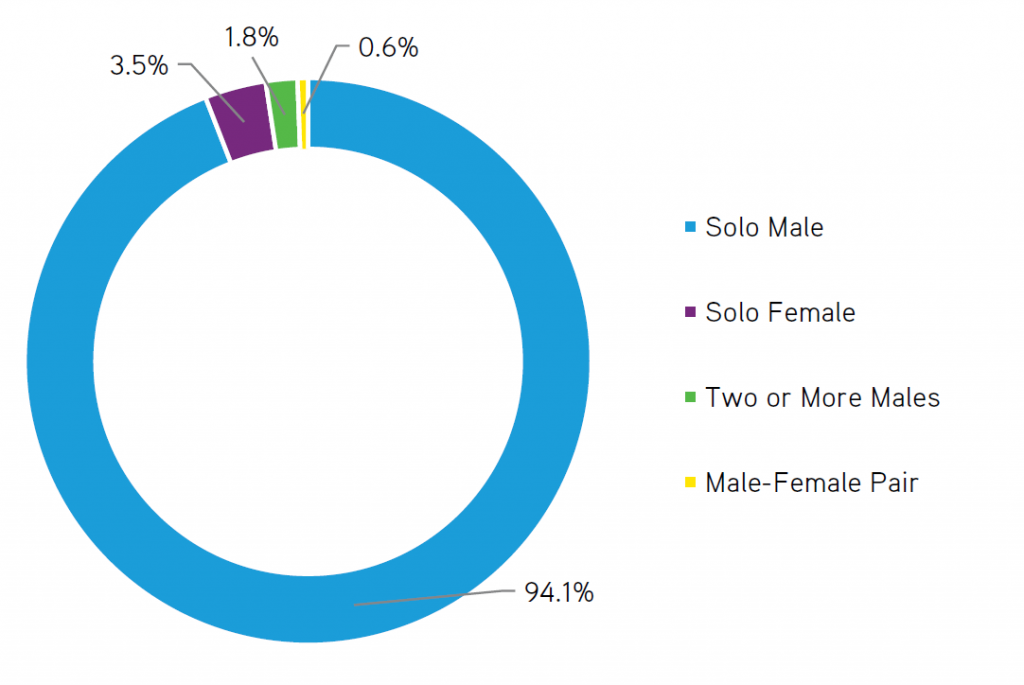
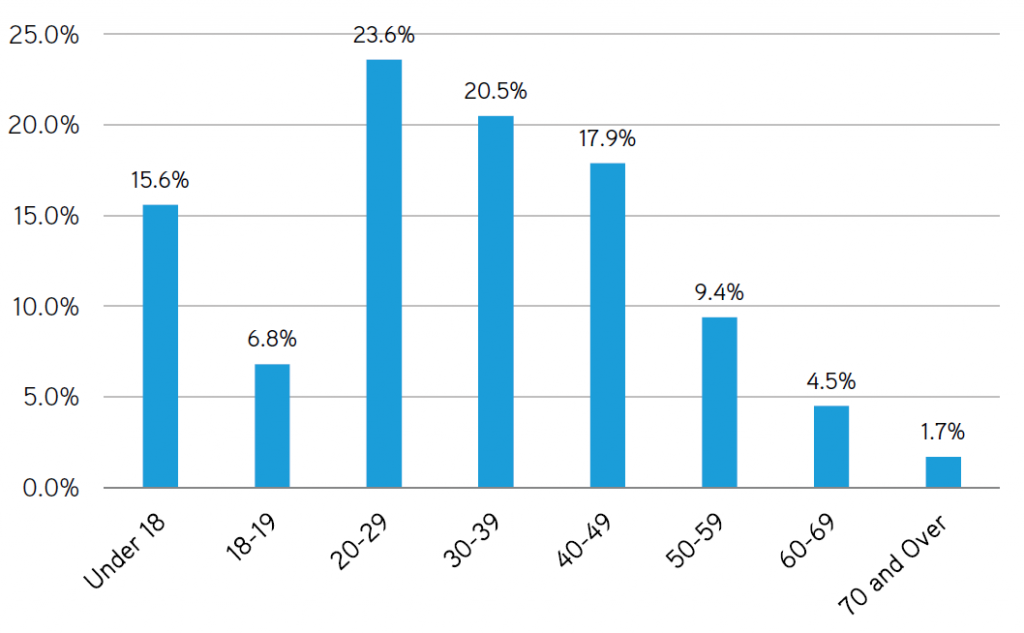
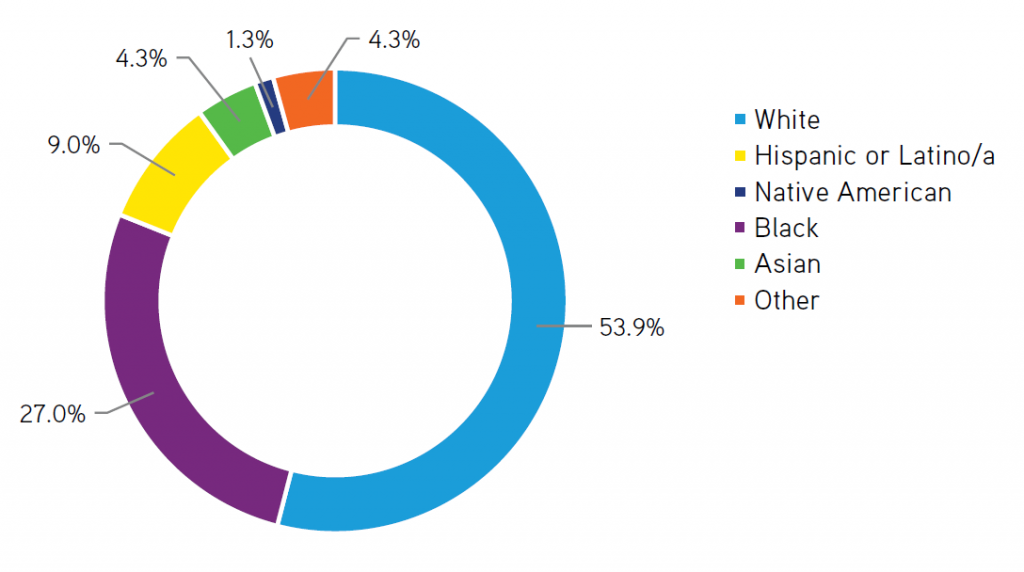
Over the fifty-one-year period examined (1966-2016), mass shootings have been steadily increasing each year (Figure 6). While several of the earlier years experienced no mass shootings (based on the definition used here), five years exceeded twenty events, all of which occurred within a six-year period (2009-14). The most shootings in one year (twenty-two) took place in 2009.
When examining the distribution of the number of events by decade, as illustrated in Figure 7, we again can observe the continual increase in mass shootings. While there were only twelve such events between 1966 and 1975, 183 mass shootings were identified during the period between 2006 and 2016. Additionally, there is a steady increase in the average number of events per year when examining mass shootings over the last five decades. Still, on average, there are fewer than twenty mass shootings annually.
There is a steady increase in the average number of events per year when examining mass shootings over the last five decades. On average, under Schildkraut and Elsass’s definition, there are between nineteen and twenty mass shootings annually.
Finally, while the risk of becoming the victim of a mass shooting is extremely low, there has been a similar increase in this rate over time (Figure 8). Using data from the U.S. Census to account for changes in population over time, the average incidence rate for total victimization (both injuries and fatalities) due to mass shootings between 2006 and 2016 was nearly 0.04 per 100,000 people in the population, almost seven times greater than the incidence rate between 1966 and 1975. Since 1986, individuals victimized in a mass shooting were more likely to be injured rather than killed. This is due, at least in part, to improvements in medical technology, advances in active shooter training and related protocols, and faster response times by law enforcement and other first responders.
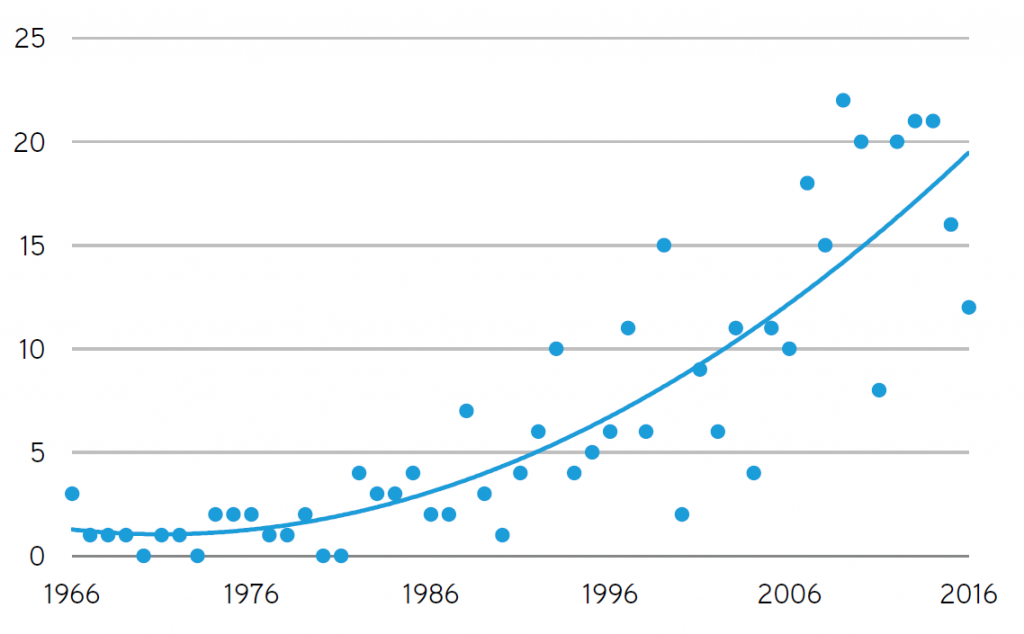
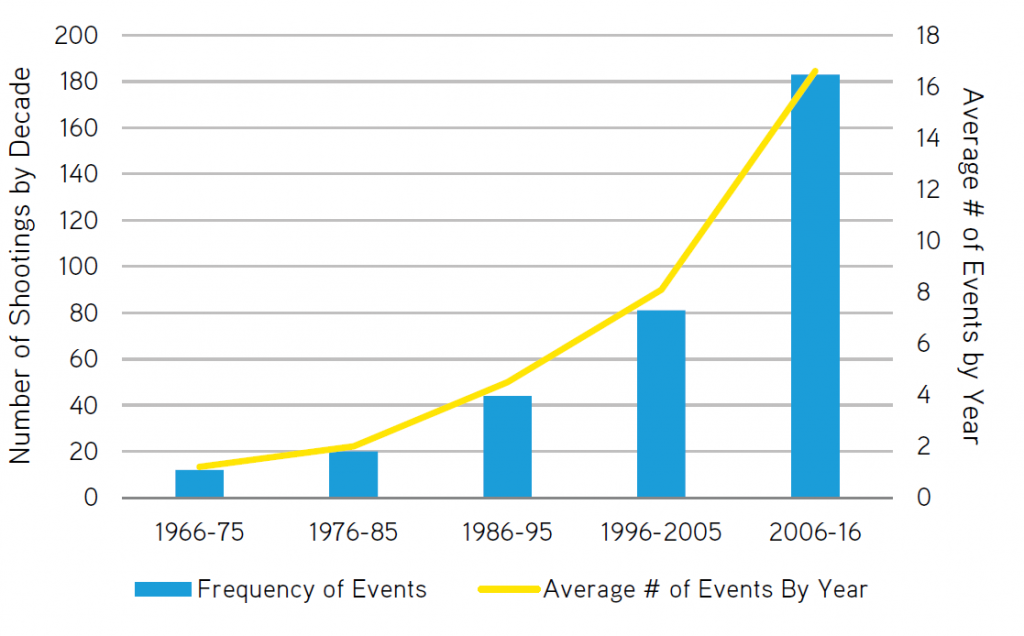
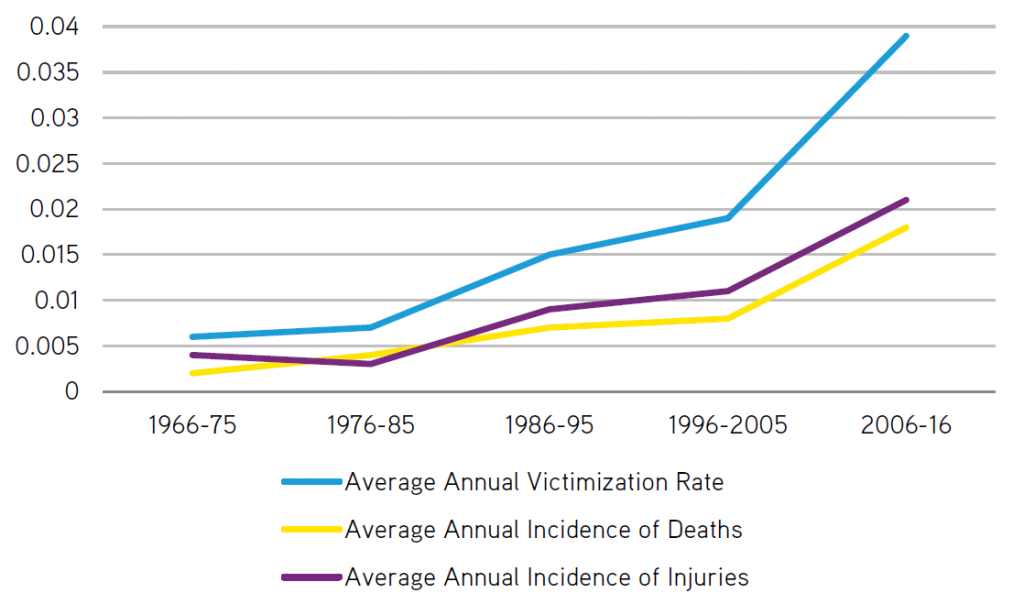
Knee-jerk reactions rooted in emotion will not solve the problem. The evidence produced to date shows that the problem requires solutions that are versatile and grounded in evidence in order to be effective. Although mass shootings occur considerably less frequently than portrayed by the media, the findings are that they have increased over time. While some of our most populous states have experienced a majority of the mass shootings over time, there are states that have never had one. Schools and workplaces are more likely to be the site of a mass shooting and policy efforts should focus more intensely in those areas. Further, although common public perceptions of mass shootings include use of assault rifles, more than three-quarters of mass shootings actually involve handguns. Therefore, it is incumbent to find evidence-based solutions to this growing problem. Given the regional, demographic, and type of gun used data, a one-size-fits-all approach may not work — tailored solutions may work better depending on the state and the community. Future works by the consortium will explore these issues.
Jaclyn Schildkraut is an assistant professor of public justice at SUNY Oswego and a national expert on mass shootings.
Margaret K. Formica is an assistant professor of public health and preventive medicine at SUNY Upstate Medical University.
Jim Malatras is president of the Rockefeller Institute of Government.
[1] Jaclyn Schildkraut, H. Jaymi Elsass, and Kimberly Meredith, “Mass shootings and the media: why all events are not created equal,” online article, Journal of Crime and Justice, February 5, 2017, https://www.tandfonline.com/doi/full/10.1080/0735648X.2017.1284689.
[2] For example, the 2012 shooting at Sandy Hook Elementary School was identified as reflective of broader societal problems, while those events in Tucson, Arizona (2011), and Aurora, Colorado (2012), were perceived to be isolated events. See “Washington Post-ABC News Poll,” WashingtonPost.com, accessed March 29, 2018, http://www.washingtonpost.com/wp-srv/politics/polls/postabcpoll_20121216.html.
[3] See, for example, Robert J. Kaminski, Barbara A. Koons-Witt, Norma Stewart Thompson, and Douglas Weiss, “The impacts of the Virginia Tech and Northern Illinois University shootings on fear of crime on campus,” Journal of Criminal Justice 38, 1 (2010): 88-98; Ronald Burns and Charles Crawford, “School shootings, the media, and public fear: Ingredients for a moral panic,” Crime, Law and Social Change 32, 2 (1999): 147-68; and Jaclyn Schildkraut, H. Jaymi Elsass, and Mark C. Stafford, “Could it happen here? Moral panic, school shootings, and fear of crime among college students,” Crime, Law and Social Change 63, 1-2 (2015): 91-110.
[4] Jaclyn Schildkraut and Tiffany Cox Hernandez, “Laws That Bit The Bullet: A Review of Legislative Responses to School Shootings,” American Journal of Criminal Justice 39, 2 (2014): 358-74. There are, however, exceptions to this. After the Columbine shooting, the state of Colorado was successful in passing several gun control measures, including a reinstatement of background checks and prohibitions on “straw purchase” (the buying of a gun on someone else’s behalf). Similarly, after the Sandy Hook event, New York State enacted comprehensive antigun violence laws called the SAFE Act.
[5] When the investigation subsequent to the 2007 shooting at Virginia Tech revealed a loophole that prevented the shooter’s involuntary detention for mental health concerns from being reported into the National Instant Criminal Background Check System (NICS) — which, as required by the Gun Control Act of 1968, would have disqualified him from legally purchasing his firearms — new legislation was passed aimed at addressing the issue. By the time of the 2012 shooting at Sandy Hook Elementary School, it still was estimated that millions of records were missing from the system. In 2017, after a gunman killed twenty-six at a church in Sutherland Springs, Texas, it was revealed that his domestic violence conviction (another disqualifying factor) also had not been reported to the NICS by the U.S. Air Force. He too had legally purchased the gun used in the shooting. Similarly, in the aftermath of many high profile mass shootings, gun control proponents often call for a renewed assault weapons ban, even though one was in effect when the Columbine shooting happened and that one of the guns used in the attack (the Intratec TEC-DC) was on the list of prohibited weapons.
[6] Chloe Aiello, “17 school shootings in 45 days — Florida Massacre is one of many tragedies in 2018,” CNBC, February 16, 2018, https://www.cnbc.com/2018/02/14/florida-school-shooting-brings-yearly-tally-to-18-in-2018.html.
[7] “School Shootings In America Since 2013,” Everytown For Gun Safety, accessed March 30, 2018, https://everytownresearch.org/school-shootings/5837/.
[8] William J. Krouse and Daniel J. Richardson, Mass Murder with Firearms: Incidents and Victims, 1999-2013 (Washington, DC: Congressional Research Service, July 30, 2015), https://fas.org/sgp/crs/misc/R44126.pdf.
[9] David Deacon, “Yesterday’s Papers and Today’s Technology: Digital Newspaper Archives and ‘Push Button’ Content Analysis,” European Journal of Communication 22, 1 (2007): 5-25.
[10] Jaclyn Schildkraut and H. Jaymi Elsass. Mass Shootings: Media, Myths, and Realities (Santa Barbara: Praeger, 2016).
[11] Due to the primary reliance on media accounts to identify incidents, it is possible that not every single mass shooting event has been captured. Still, it is believed that these data are among the most comprehensive of sources, as all will have an inherent margin of error for missing events.
[12] One example of this is the 2014 shooting in the Isla Vista community of Santa Barbara, California.
[13] Based on author computations. This calculation is not included in the figures presented.